INTRODUCTION
Well. Finally. I can cross off my list something I have been meaning to do since the morning of 23 June 2016 when I first commented on GP – contribute an article. There have been numerous failed attempts at writing a first contribution along the way, including pieces on: Operation Mincemeat, skiing, everything about the Bloody Mary, various Royal Navy themed pieces and a few favourite recipes. So, notwithstanding the above, I offer a somewhat lengthy postcard about a day out which we enjoyed late June 2021.
WINDERMERE
There are sixteen lakes in the Lake District, the largest being Windermere. Only one, Bassenthwaite Lake, is officially a lake by name, the others are meres or waters (remember this for the pub quizzers).
The southeastern part of the Lake District National Park is the best known and most visited part of the National Park. measures ten and a half miles long and a mile and a quarter across at its widest point, with a depth of up to 220 feet. The lake is sufficiently large that it is reported to have a slight but discernible tide (although I have never noticed this).
Windermere is also the most commercialized of the English Lakes and a tourist magnet, which can often be very crowded in the spring and summer months, particularly along the east bank and parking spaces in the area can often be difficult to find. The less populated west bank of the lake is generally much quieter (top tip for those with cars who want to enjoy the Lake shore for a picnic – head for the west bank. This is easily reached from the South at Newby bridge and driving up past Lakeside, or crossing the lake on the ferry from Bowness on foot or with vehicle).
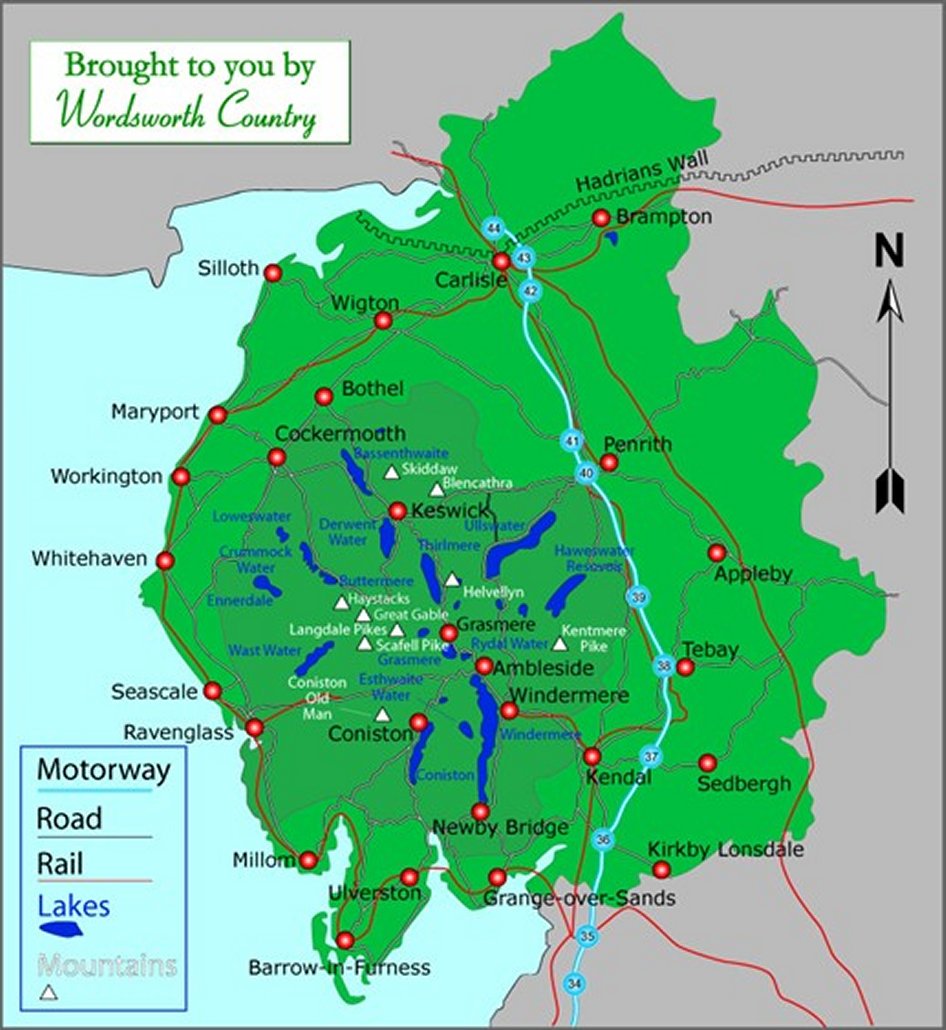
LAKESIDE & HAVERTHWAITE RAILWAY
The Lakeside and Haverthwaite Railway is found just off the A 590 past Newby Bridge and runs from the Haverthwaite Station up to Lakeside station. Ample parking (free of charge) is available on site, with a playground for the little’uns and a tearoom (operating takeout only due to muh Covid when we visited) and souvenir shop.

Now MrsE arranged the ticketing as it was a treat for me, but I believe it is easily arranged online. At the time it was book in advance only, but having just checked it appears that one can now buy only on the day from the ticket office at the station – this obviously presents a few worries due to the potential lack of availability. Combined tickets for the return railway journey plus boat trip to Bowness can be bought together for £19.50 (Adult), £11.00 (Child 3-15) or £55.00 Family (2 Adults, 3 Children). So it’s hardly a cheap day out.
The railway currently has a number of steam engines available to it. On the day we went, it was Victor. Built in the UK by W. G. Bagnall & Co Ltd, works number 2996 was one of three locomotives ordered by the Steel Company of Wales (SCOW) for their Abbey, Margam and Port Talbot works in 1950. At SCOW, the locomotive was given running number 403 and, with its two sister engines, performed above and beyond the requirements of its original design. However, in 1957 all three were replaced by diesels and 2996 was sold, with sister 2994, to the Austin Motor Company Ltd. (later to become British Leyland) for use at their Longbridge plant in Birmingham. Then in 1988 ‘2996’ went to the Strathspey Railway for a time then on to the Great Central Railway (Nottingham section) at Ruddington. At Austin’s, the locomotives were named “Victor” and “Vulcan”, and continued in service until late 1973 when they were sold on to West Somerset Railway
In 2009, “Victor” was privately purchased for use on the Lakeside & Haverthwaite Railway where it underwent extensive restoration.
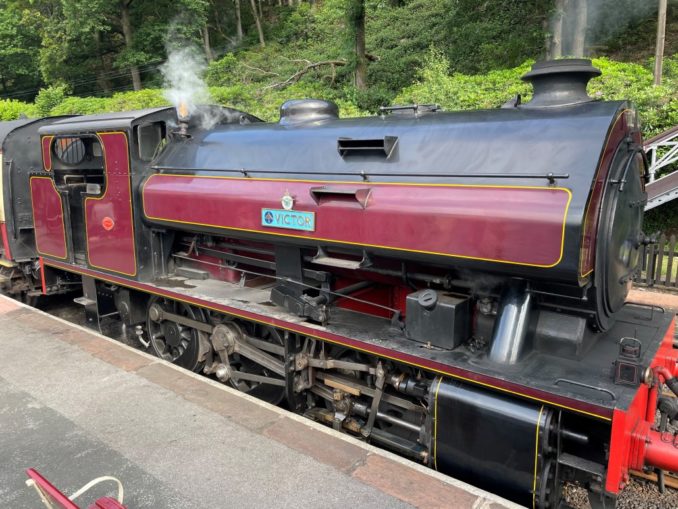
The Platform, footbridge and walkway on the far side of the track offer a good opportunity to get close to the locomotive (and breathe the heat and smell of the coal burner), and if you ask any of the train staff they are happy to talk detail about the trains.


As you can see from the pictures, the engine is lovingly maintained and coupled to rolling stock which is mostly from the 1950s, offers seating in either open layout (passageway down the centre) or some carriages have compartments.
The 3.5 mile ride is a gentle one, passing by cuttings in the hill to the West, and with views over the outflow from the southern end of Windermere to the East (River Leven). It passes Whitewater and Newby Bridge enroute Lakeside.

On arrival at Lakeside, be aware that if you have a combined ticket you will need to exchange your voucher for a boat ticket at the office. A bit of a faff but best to know in advance as it isn’t made particularly clear. Lakeside was established as a steamer pier for services along the lake when the Lakeside branch of the Furness Railway reached it in 1869, meaning that steamer services no longer had to negotiate the River Leven to Newby Bridge. Also built at Lakeside was a hotel to serve the tourists brought by the railway and steamers – the Lakeside Hotel & Spa which looks rather nice. The jetty itself is pretty basic, be prepared for queues in peak season, although the train and boat timetables are aligned which means waiting is minimised. It does have a refreshment shop however, combined with lovely views up the lake to the North, across to Fell Foot national park and the prominent hill is Gummers How, a lookout which is well worth a visit of its own. There is also an Aquarium at Lakeside which I have never visited.

THE CRUISE
The vessel that we had for our trip was MV Tern. The Furness Railway commissioned Forrest & Sons of Wyvenhoe, Essex, to design and build a new Steamer in 1890. Originally to be called Swallow, a last-minute change of heart resulted in the vessel being named Tern. In the winter of 1957/58, TERN was re-engined with two six-cylinder 120-bhp Gleniffer diesels, her tall funnel was replaced by a shorter, raked funnel. The Tern is 145ft in length and weighs 121 tonnes and carries up to 350 passengers.
The ship is wheelchair accessible on the outer deck only. Passenger facilities include: refreshment bar and licensed bar, two heated inner saloons – one at the front of the vessel and one at the rear, promenade outside deck with lots of seating. (Tip on seating – suggest you get under shade if it’s a rare hot day in the Lakes, likewise if it’s wet and cold ensure you have your outerwear available if you want to enjoy the view). The Lakeside-Bowness trip takes approximately 40 minute.

Most of the Covid restrictions we had to put with are hopefully gone now. Note that the crew are a fairly grumpy bunch, although after exchanging rather heated words with the Captain who was getting all in a bother about LittleE not wanting to sit still for the best part of an hour, he was much friendlier on the return leg.
The ship cruises serenely up the lake, and they do provide some information on various sights and landmarks, a selection of which I have included on this postcard. We alighted at Bowness, although one can pay to go on to Ambleside. The Lakeside to Bowness trip is on the East side of the lake, and the sights and commentary are focussed on that shore. The reverse trip is largely on the West side of the lake and the focusses on that much more sparsely inhabited shore.
SOME SIGHTS: FISHER’S HOUSE
Sir John Fisher, born Barrow-in Furness, joined his father’s shipping business in 1914. On the outbreak of World War II he was recruited by the Ministry of War Transport as Director of the Coasting and Short Sea Division. Two of the most difficult jobs he tackled were ‘Operation Dynamo’, the evacuation of Dunkirk and ‘Operation Neptune’, the nautical part of the D-Day landings. For his war service he was knighted in 1942 and received decorations from France, the Netherlands, Spain and Portugal. He married the famous Viennese opera singer Maria Eisner on 24th January 194 7. Their home was ‘Blakeholme Wray’, by the side of Windermere, purchased from Sir Charles Craven, the Managing Director of Vickers Shipyard, and known locally as Fisher’s House. It is one of a number of stunning properties around the lake.
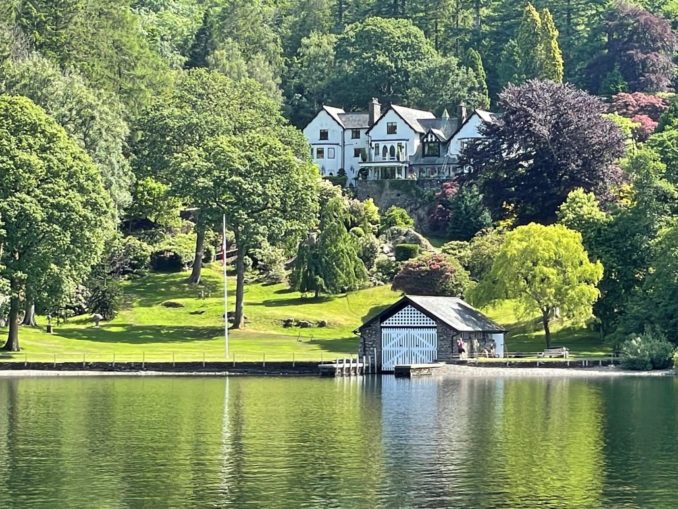
SOME SIGHTS: HILL OF OAKS
Tucked away in woodland on the south-eastern shores of Lake Windermere you will see Hill of Oaks Lodge & Caravan Park – advertising itself as the ideal base for exploring the best of the Lake District. What I never knew about the place before the boat trip was that Hill of Oaks was where Edward Wakefield made history by becoming the first person to take a plane off from water in 1911. This feat and the site subsequently caught the interest of the Admiralty and later became RNAS Hill of Oaks. I will leave this rather scant level of detail as Hill of Oaks deserves an article of its own which I will look into.
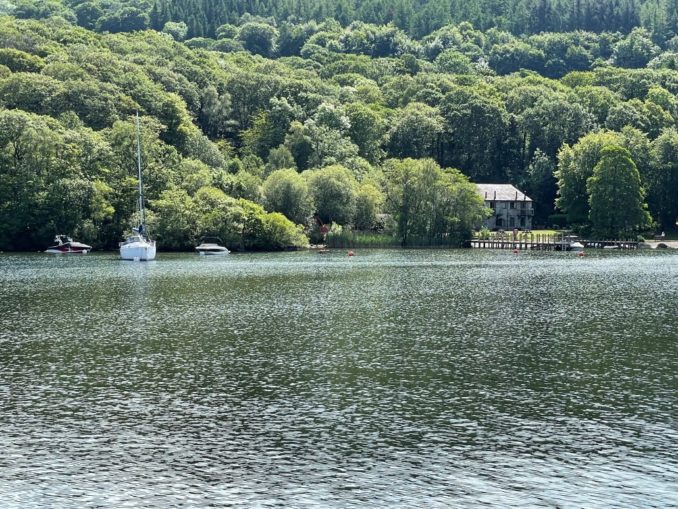
SOME SIGHTS: STORRS HALL
Just south of Bowness sits a lakeside hotel called Storrs Hall. Included here not only as it is where MrsE and I tied the knot (noting that we got nothing like the beautiful weather on that special day as we did for this day out!), but also being an ex-Matelot Storrs Temple is of interest.
Storrs Hall and boathouse was built in the 1790s by the Yorkshire landowner Sir John Legard. In 1808 Storrs was bought by John Bolton, an Ulverston born, Liverpool based merchant, whose fortune was derived from his activities as a slave trader. Storrs Hall was inherited by his nephew, the Reverend Thomas Staniforth, who left no family. Thereafter Storrs Hall was then purchased by Benjamin Townson of Barrow-in-Furness in 1890, to become a hotel catering to the increasing popularity of the Lake District as a leisure destination. North British Trust Hotels, who bought the Hotel in 1943, introduced more spectacular features such as the main bar bought from Blackpool’s Tower Ballroom. It was then bought in 1997 by Les Hindle, a Lancashire businessman, who carried out a sympathetic restoration; and it remains in the ownership of the Hindle family today.

The grandly-named ‘Temple of Naval Heroes’ stands at the end of a narrow causeway that leads from the grounds of Storrs Hall out into the water, offering magnificent views up and down the lake.. The octagonal building carries plaques celebrating four great naval victors in the (at the time) ongoing war against the French– Admirals Howe, St Vincent, Duncan and Nelson. If one is on foot in the area, the Temple is accessible through the hotel grounds as it is National Trust property.
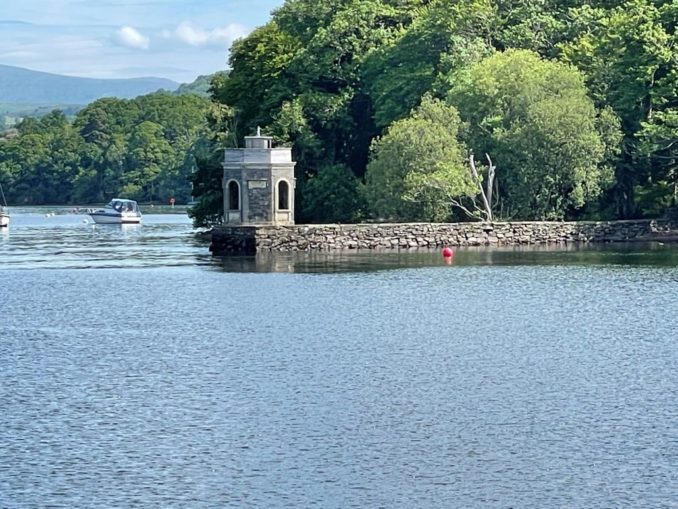
BOWNESS
Bowness reportedly has its origins in the 11th century, when the area was colonised by the invading Vikings, the name is said to derive from the Old Norse ‘boga naes’ meaning ‘promontory shaped like a bow’. The town has now merged with Windermere town, originally known as the hamlet of Birthwaite, which owes its development to the arrival of the Kendal and Windermere railway, the establishment of which was staunchly opposed by the poet William Wordsworth, concerned that the influx of visitors would spoil the natural appeal of the lake.
Bowness is a nice enough place, somehow combining tacky elements of a seaside town with the slightly more upscale, all in a Lake District National Park town, but be warned it gets very busy indeed and the narrow pavements ensure there is not enough space for the amount of people visiting. Due to the Beatrix Potter museum and shop the town sees large numbers of Japanese tourists who are obsessed with Beatrix Potter.
We opted to take a picnic with us and walked a short distance from Bowness, past the shoreline businesses, through the park and sat on the beach at Cockshott Point. Otherwise there are no shortage of places to eat and drink ranging from tea shops, bars, pubs, restaurants etc. I am a big fan of the takeaway fish and chips from Joe Vinegar, conveniently located 2 minutes’ walk from the jetties on the main street through Bowness.
A FINAL NOTE
We had an enjoyable day out, despite work trying their best to ruin it with an emergency that required attention, and LittleE chafing at being stuck on the boat. As I mentioned above, it is hardly the cheapest day out, but get the timings right and avoid the worst of the crowds and it has a fair amount of charm to it. When we visit the Lakes I always have my car so next time I want a picnic at Cockshott Point or elsewhere I will just drive and park – this makes LittleE management significantly easier as well…!
A note on timings: we got the first train out in the morning, and had prebooked timings for the whole day, returning to Haverthwaite for approximately 3:00pm, which in hindsight wasn’t really enough time in Bowness. If you want to have a leisurely lunch in Bowness (or Lakeside if doing the trip in reverse) ensure you leave yourself enough time to do so, noting that the Last Bowness-Lakeside departure to catch the final train is at 4:00pm. Not sure how the train company is managing their timings or capacity now that people are not booking in advance to avoid people having long waits for the return trips – might be sensible to call them in advance.
Overall I would certainly recommend this for a relaxed day out in the Lakes, particularly if the weather is fine and one isn’t overly interested in getting up on to the fells. Other places worth potentially visiting in and around the southern end of Windermere include:
- Fell Foot Park. Bordering the south eastern end of Windermere. Due to muh Covid tickets needed to be booked in advance for the parking and entry, but no time limit on visit once in the park. The park has good access to the water, plenty of space for picnics and a café/eatery. https://www.nationaltrust.org.uk/fell-foot
- Gummers How. A well known lookout (mentioned above). Visitors can drive to the carpark and walk the last section for outstanding views over Windermere. https://www.lakeswalks.co.uk/walks/gummers_how/
- Lakeland Motor Museum. Just off the A590 at Backbarrow between Newby Bridge and Haverthwaite. Never been myself. One for a rainy day perhaps https://www.lakelandmotormuseum.co.uk/.
© Endeavour 2021
The Goodnight Vienna Audio file
Audio Player



